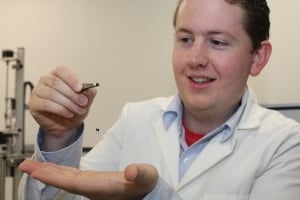Gold standard!
Research news
Deakin University has another sizeable step toward becoming a world leader in developing state of the art carbon fibre composites - the building materials of the 21st century.
The University has just taken possession of a Favimat (AI) Robot2, the only one in Australia and one of just 15 in the world.
“This is a very exciting time for us at Deakin,” said Associate Professor Bronwyn Fox, who heads the carbon fibre composites group at the University.
“The Favimat machine allows us to simultaneously measure the linear density and tensile properties of individual carbon fibres which are less than a tenth of the diameter of a human hair and very difficult to handle.
"It is the gold standard for testing carbon fibres.
“It robot-automatically loads and tests up to 500 samples which means we can be very confident with our measurements.
“For man-made fibres and some natural fibres, single fibre tests are labour intensive and require a high level of both skill and patience, the Favimat removes the need for a highly trained engineer.
“This and a number of other characteristics of the Favimat result in a significant reduction in both operator input and associated costs as well as a reduc?tion in possible fibre damage which means that the results are highly reliable. This combined with the arrival of the new Surface Energy Analyser in February will give us a unique capability to characterise carbon fibres.”
Moreover, what the arrival of the Favimat really does for us is re-confirm that Deakin, and the Geelong region, is now a leading player in the field of carbon fibre composites, which are regarded as not only the materials of the 21st century, but the 22nd and beyond.
“Although they were first produced in the 1960s and 1970s they are really only now coming into their own,” Associate Professor Fox said.
“They have, for example, huge applications in the aerospace industry.
“The Boeing 787 Dreamliner is 50 per cent composite materials by weight and the new Airbus A350 XWB will be 53 per cent composite by weight.
“These materials play an enormous role in making aircraft more lightweight so that they are more fuel efficient and produce fewer environmental emissions.
“In addition to that, carbon fibre composites have a huge impact on the way we look at alternative energy, particularly blades for wind turbines.
“They also have the ability to reduce the weight of motor vehicles, for example, in the USA, Tesla use carbon fibre composites as the material of choice for their cutting edge electric vehicles.”
Another recent development in Geelong’s ambitions for world leadership in carbon fibre composites is the confirmation that Deakin had reached agreement with Despatch Industries to build a carbon fibre production line on the Waurn Ponds campus.
This will be part of the Australian Carbon Fibre Research Facility (ACFRF), the only one of its type in the world, which is to be housed within the Australian Future Fibres Research and Innovation Centre (AFFRIC).
AFFRIC is a partnership between Deakin University, the CSIRO and the Geelong-based Victorian Centre for Advanced Materials Manufacturing (VCAMM).
“At the moment there are some scientists doing lab-scale experiments in carbon fibres and there are others in industry involved production,” Associate Professor Fox said.
“They can’t utilise existing carbon fibre production lines for research because it means a loss of production and the lab scale experiments are unable to replicate the tension on the fibre in production.
“We have found a real niche for ourselves at the pilot scale for making carbon fibre where we can do some world-class research.
“This gives us the ability to look at new ways of making carbon fibres as well as developing the next generation of carbon fibres.”
The creation of ACFRF and AFFRIC has attracted huge interest in the Geelong region from overseas.
In February last year, some of the world’s leading researchers in and users of carbon composite fibres attended a conference in Geelong.
These included representatives of Boeing, Lockheed Martin and a Russian consortium.
“Since then, they have continued to keep themselves up to date with developments and we have a global network of supporters,” Associate Professor Fox said.
“They know that what we are doing is real breakthrough, frontier science and they want to be part of it.
“They will be greatly encouraged by the arrival of the Favimat machine, and confirmation of the production line, that we are genuine in our desire to be the hub of future carbon fibre composite research in the world.”
Something else that has Associate Professor Fox excited is the role carbon fibre composites can play in helping with the Geelong region’s transition from old manufacturing industries to modern, high tech new ones.
“I am passionate about the future of manufacturing in the Geelong region so to be involved in the creation of new industry opportunities in my home town is pleasing indeed,” she said.
“The research facility will help bring carbon fibre manufacturing into the region, creating high tech jobs.”
The ACFRF is expected to be operational in 2013.
Share this story
 A single thread of carbon fibres is all but invisible to the naked eye.
A single thread of carbon fibres is all but invisible to the naked eye.
